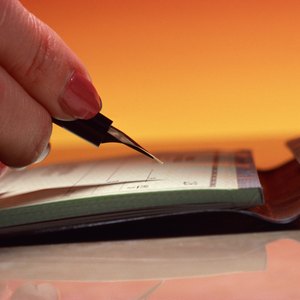
Your checking account is a place to deposit your money so you can use it to pay for expenses. The bank holds onto the money for you and in some cases, might even pay you interest on the funds while they remain in the account. When you want to use the money, you can withdraw it in a number of ways. Your bank account balance can drop below zero if you withdraw or spend more money than you have in your account.
Checking Account Deposits and Withdrawals
Ways to access the money in your checking account include making withdrawals from your local branch or an ATM, making purchases with your debit card, writing checks or setting up electronic transfers from your account (often via automated clearing house, or ACH, and so these transfers are often called ACH transfers).
The running balance in your bank account is shown in your monthly statements. Most banks also allow you to register for online access to your account records. When you deposit money, the balance goes up; when you use money, the balance goes down.
Read More: How to Withdraw Money From a Bank Account
Overdrawing Via Checks or ACH
If you write a check or make an ACH transfer for more than the amount you have in your account, your account will be overdrawn, and the transaction creates an overdraft. Although each bank has its own rules, generally, if you overdraw your account, the bank will cover the transaction for you. This is called overdraft protection, and it saves you from bouncing checks or having electronic transfers returned as insufficient. Instead of owing the person or entity you were trying to pay, you owe the bank.
While overdraft protection is helpful in preventing bill pay disasters, it comes at a price. The bank will charge you an overdraft fee, usually $35 to $40, and your account will have a negative balance, leading to more overdrafts. If you keep making purchases or payments using your overdrawn account, it will continue to have a larger negative balance, and the bank will charge an overdraft fee for each transaction, digging the hole even deeper.
What Does Overdrafting Look Like?
To better understand how overdrafting works, imagine that you have $100 in your checking account and pay a bill online for $120. When this happens, your checking account will be overdrawn by $20. Rather than have the payment bounced or declined, the bank will pay it, but you will owe the bank that $20 difference, and your account balance will be -$20.
If the bank charges you an overdraft fee of $35, your account balance will go down further to -$55. If you then write a check for $80 not realizing what happened, your account balance will drop to -$135, and you'll incur another overdraft fee of $35 for a new account balance of -$170.
At this point, you would have no money in the account and would owe the bank $170.
Read More: How to Overdraft Your Bank Account
Overdraft Protection on Debit Cards
Under federal law, a bank can give you overdraft protection for checks and ACH transfers without your permission. However, you must choose overdraft protection for transactions involving your debit card. That includes purchases and ATM withdrawals. If you don't opt in to overdraft protection, the transaction will simply be declined if you don't have enough money in your account to cover it.
Fixing an Overdrawn Bank Account
If you consistently overdraw your bank account and don't pay overdraft fees or bring your account above zero, the bank might close your account, and you'll still owe the money. To bring your account back into the positive and avoid further overdrafts and overdraft fees, you need to deposit enough money to cover the negative balance and any transactions that are pending.
If you have no choice but to overdraw, going to the branch and pleading your case might be an option. The branch manager may agree to waive the overdraft fee if you haven't overdrawn in the past and if you bring the balance above zero.
References
- Consumer Financial Protection Bureau: What Is an Overdraft?
- Credit Karma: What Is an Overdraft Fee?
- Consumer Financial Protection Bureau: Understanding the Overdraft “Opt-in” Choice
- Bankrate: What Is an Interest Checking Account?
- Consumer Financial Protection Bureau. "A Closer Look: Overdraft and the Impact of Opting-In," Page 1. Accessed March 27, 2020.
- Consumer Financial Protection Bureau. "A Closer Look: Overdraft and the Impact of Opting-In," Page 4. Accessed March 27, 2020.
- National Credit Union Administration. "Overdraft and Non-Sufficient Funds (NSF) Fees." Accessed March 27, 2020.
- Board of Governors of the Federal Reserve System. "Federal Reserve Announces Final Rules Prohibiting Institutions From Charging Fees for Overdrafts on ATM and One-Time Debit Card Transactions." Accessed March 27, 2020.
- U.S. Government Publishing Office. "The Overdraft Protection Act of 2009." Accessed March 27, 2020.
- Consumer Financial Protection Bureau. "A Closer Look: Overdraft and the Impact of Opting-In," Page 2. Accessed March 27, 2020.
- Consumer Financial Protection Bureau. "You’ve Got Options When It Comes to Overdraft," Page 1. Accessed March 27, 2020.
- Ally Financial. "Bill Pay FAQs." Accessed March 27, 2020.
- Consumer Financial Protection Bureau. "You’ve Got Options When It Comes to Overdraft," Page 2. Accessed March 27, 2020.
- Commonwealth of Massachusetts. "Consumer Alert: Overdrawn Accounts." Accessed March 27, 2020.
Writer Bio
Rebecca K. McDowell is an attorney focused on debts and finance. She has a B.A. in English and a J.D. She has written finance and tax articles for Zacks and eHow.

